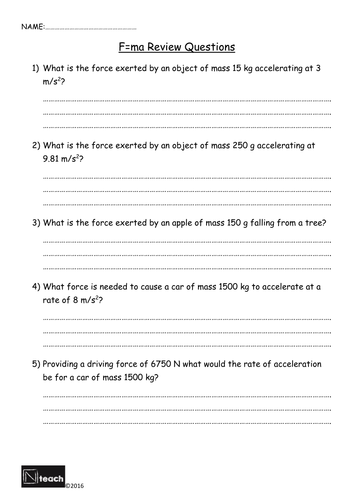




New GCSE AQA Physics lesson on 'Newtons Second Law - Force and Accerlation' written in line with new AQA Physics specification.
Starter prompts pupils to discuss how there weight would vary on different planets, this is to set-up how weight is different to mass.
Key terms Force, mass and acceleration are reviewed for clarity leading to the equation F=ma, the units, how it can be rearranged and then review questions to practice the use of.
The equation is then reviewed in terms of proportionality as required by the AQA specification.
Following this F=ma is related to W=mg to highlight that weight is a force and different to mass. This then leads to pupils calculating their mass on different planets - alternatively a task is provided to calculate the mass of a schoolbag on different planets.
For higher tier pupils intertial mass is explained.
Learning Objectives:
- Clearly explain what force, mass and acceleration are.
- Relate how mass and acceleration effect the size of a force.
- Calculate the resultant force on an object by its mass and acceleration.
- Explain the difference between weight and mass.
- What is meant by inertia (Higher Tier)
Starter prompts pupils to discuss how there weight would vary on different planets, this is to set-up how weight is different to mass.
Key terms Force, mass and acceleration are reviewed for clarity leading to the equation F=ma, the units, how it can be rearranged and then review questions to practice the use of.
The equation is then reviewed in terms of proportionality as required by the AQA specification.
Following this F=ma is related to W=mg to highlight that weight is a force and different to mass. This then leads to pupils calculating their mass on different planets - alternatively a task is provided to calculate the mass of a schoolbag on different planets.
For higher tier pupils intertial mass is explained.
Learning Objectives:
- Clearly explain what force, mass and acceleration are.
- Relate how mass and acceleration effect the size of a force.
- Calculate the resultant force on an object by its mass and acceleration.
- Explain the difference between weight and mass.
- What is meant by inertia (Higher Tier)
Get this resource as part of a bundle and save up to 44%
A bundle is a package of resources grouped together to teach a particular topic, or a series of lessons, in one place.
Something went wrong, please try again later.
Excellent- I will be using this in class with my students very shortly!
Report this resourceto let us know if it violates our terms and conditions.
Our customer service team will review your report and will be in touch.
£3.00